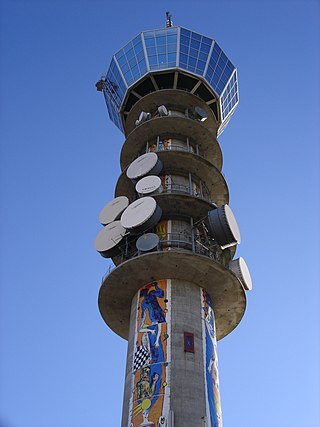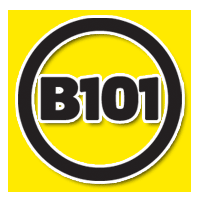Related Research Articles

Radio broadcasting is the broadcasting of audio (sound), sometimes with related metadata, by radio waves to radio receivers belonging to a public audience. In terrestrial radio broadcasting the radio waves are broadcast by a land-based radio station, while in satellite radio the radio waves are broadcast by a satellite in Earth orbit. To receive the content the listener must have a broadcast radio receiver (radio). Stations are often affiliated with a radio network that provides content in a common radio format, either in broadcast syndication or simulcast, or both. Radio stations broadcast with several different types of modulation: AM radio stations transmit in AM, FM radio stations transmit in FM, which are older analog audio standards, while newer digital radio stations transmit in several digital audio standards: DAB, HD radio, DRM. Television broadcasting is a separate service that also uses radio frequencies to broadcast television (video) signals.
Co-channel interference or CCI is crosstalk from two different radio transmitters using the same channel. Co-channel interference can be caused by many factors from weather conditions to administrative and design issues. Co-channel interference may be controlled by various radio resource management schemes.

Low-power broadcasting is broadcasting by a broadcast station at a low transmitter power output to a smaller service area than "full power" stations within the same region. It is often distinguished from "micropower broadcasting" and broadcast translators. LPAM, LPFM and LPTV are in various levels of use across the world, varying widely based on the laws and their enforcement.

The FM broadcast band is a range of radio frequencies used for FM broadcasting by radio stations. The range of frequencies used differs between different parts of the world. In Europe and Africa and in Australia and New Zealand, it spans from 87.5 to 108 megahertz (MHz) - also known as VHF Band II - while in the Americas it ranges from 88 to 108 MHz. The FM broadcast band in Japan uses 76 to 95 MHz, and in Brazil, 76 to 108 MHz. The International Radio and Television Organisation (OIRT) band in Eastern Europe is from 65.9 to 74.0 MHz, although these countries now primarily use the 87.5 to 108 MHz band, as in the case of Russia. Some other countries have already discontinued the OIRT band and have changed to the 87.5 to 108 MHz band.
In U.S., Canadian, and Mexican broadcasting, a city of license or community of license is the community that a radio station or television station is officially licensed to serve by that country's broadcast regulator.

HD Radio (HDR) is a trademark for an in-band on-channel (IBOC) digital radio broadcast technology. HD radio generally simulcasts an existing analog radio station in digital format with less noise and with additional text information. HD Radio is used primarily by AM and FM radio stations in the United States, U.S. Virgin Islands, Canada, Mexico and the Philippines, with a few implementations outside North America.
In telecommunications, a spectral mask, also known as a channel mask or transmission mask, is a mathematically defined set of lines applied to the levels of radio transmissions. The spectral mask is generally intended to reduce adjacent-channel interference by limiting excessive radiation at frequencies beyond the necessary bandwidth. Attenuation of these spurious emissions is usually done with a band-pass filter, tuned to allow through the correct center frequency of the carrier wave, as well as all necessary sidebands.

FM broadcasting is a method of radio broadcasting that uses frequency modulation (FM) of the radio broadcast carrier wave. Invented in 1933 by American engineer Edwin Armstrong, wide-band FM is used worldwide to transmit high-fidelity sound over broadcast radio. FM broadcasting offers higher fidelity—more accurate reproduction of the original program sound—than other broadcasting techniques, such as AM broadcasting. It is also less susceptible to common forms of interference, having less static and popping sounds than are often heard on AM. Therefore, FM is used for most broadcasts of music and general audio. FM radio stations use the very high frequency range of radio frequencies.

WBEB is a commercial radio station licensed to serve Philadelphia, Pennsylvania. Owned by Audacy, Inc., the station broadcasts an adult contemporary format, switching to Christmas music for part of November and December. The broadcast tower used by the station is in the Roxborough section of Philadelphia at, The radio studios are co-located within Audacy's corporate headquarters in Center City, Philadelphia.
WTKL is a radio station on 91.1 FM in North Dartmouth, Massachusetts. It is an owned-and-operated station of the national K-Love Contemporary Christian network, covering the South Coast of Massachusetts from a tower located on the campus of the University of Massachusetts Dartmouth.
In electronics, crosstalk is any phenomenon by which a signal transmitted on one circuit or channel of a transmission system creates an undesired effect in another circuit or channel. Crosstalk is usually caused by undesired capacitive, inductive, or conductive coupling from one circuit or channel to another.

WXZX is a commercial radio station that is licensed to serve Hilliard, Ohio and serves the Columbus metropolitan area. Owned by iHeartMedia, the station broadcasts an alternative rock format. Both the WXZX studios and the station transmitter are located in Downtown Columbus. The station is the Columbus affiliate of the Cincinnati Bengals Radio Network.

WWKL is a commercial radio station licensed to serve Hershey, Pennsylvania. Owned by Cumulus Media, it broadcasts a contemporary hit radio format.

WWBB is a radio station in Providence, Rhode Island, United States. The station plays classic hits from the 1970s, 1980s and 1990s. WWBB's offices and studios are located on Oxford Street in Providence, on the 3rd and 4th floors of the Roland Building near Interstate 95. WWBB's transmitting antenna is located on the roof of One Financial Plaza, also in Providence. WWBB transmits a directional signal to reduce interference to Boston-based sister station 101.7 WBWL. The station is owned by iHeartMedia, Inc.

WPST is a commercial radio station licensed to Trenton, New Jersey, airing a CHR format. Owned by Townsquare Media, the station serves Central Jersey, the Delaware Valley, Philadelphia and its northern and eastern suburbs.
WARM-FM is a commercial radio station licensed to serve York, Pennsylvania. It is owned and operated by Cumulus Media through licensee Radio License Holding SRC LLC and airs an adult contemporary music format, using the slogan "Today's Hits and Yesterday's Favorites". For much of November and December, it switches to Christmas music. Syndicated programming on WARM-FM includes The John Tesh Radio Show on weeknights, both the 1980s and 1990s versions of Backtrax USA on Saturday nights, and Your Weekend with Jim Brickman Sunday mornings.

WSOX is a commercial radio station licensed to serve Red Lion, Pennsylvania. The station is owned by Cumulus Media through licensee Radio License Holding SRC, LLC and broadcasts a classic hits format. The station's service contour includes the metro areas of York, Harrisburg, Lebanon, Gettysburg and Lancaster, Pennsylvania, as well as the northern suburbs of Baltimore, Maryland. Its broadcast tower is located near Red Lion at.

Mix is a Malaysian national radio station managed by Astro Radio, a subsidiary of Astro Malaysia Holdings Berhad. The station plays adult contemporary music from the 90s and now, targeting listeners between the ages of 25 and 39. In 2015, as according to Nielsen RAM Survey Wave #2, Mix FM recorded an average weekly audience of 245,000.
Broadcast call signs are call signs assigned as unique identifiers to radio stations and television stations. While broadcast radio stations will often brand themselves with plain-text names, identities such as "cool FM", "rock 105" or "the ABC network" are not globally unique. Another station in another city or country may have a similar brand, and the name of a broadcast station for legal purposes is normally its internationally recognised ITU call sign. Some common conventions are followed around the world.
KSJU was a college radio station at College of Saint Benedict and Saint John's University in Collegeville, Minnesota. Broadcasting as a carrier current AM radio station from 1954 to 1977 and on FM from 1977 to 1988, it was forced to drop its FM broadcasts due to the sign-on of new radio stations that held priority over its 10-watt facility. Today, the station operates online as "KJNB".
References
- ↑ Avener, Maggie (November 2010). "Inside the Low Power FM Movement". Monitoring Times. Vol. 29, no. 11. p. 14.
- ↑ Douglas-Young, John (1981). Illustrated encyclopedic dictionary of electronics. West Nyack, N.Y: Parker. p. 22. ISBN 0-13-450791-6.